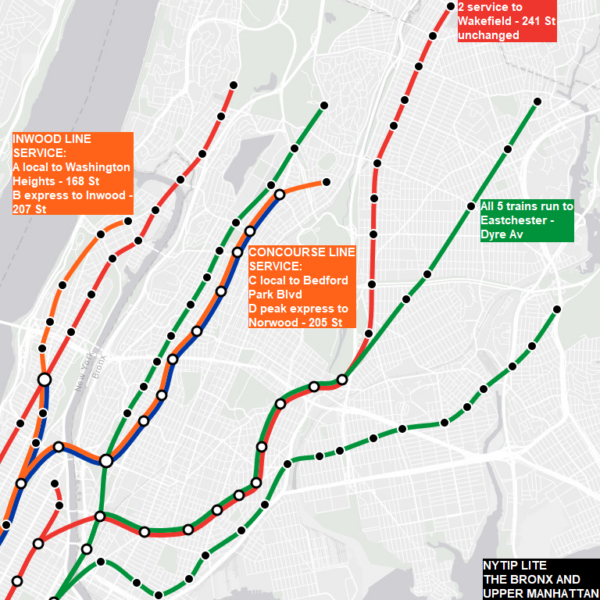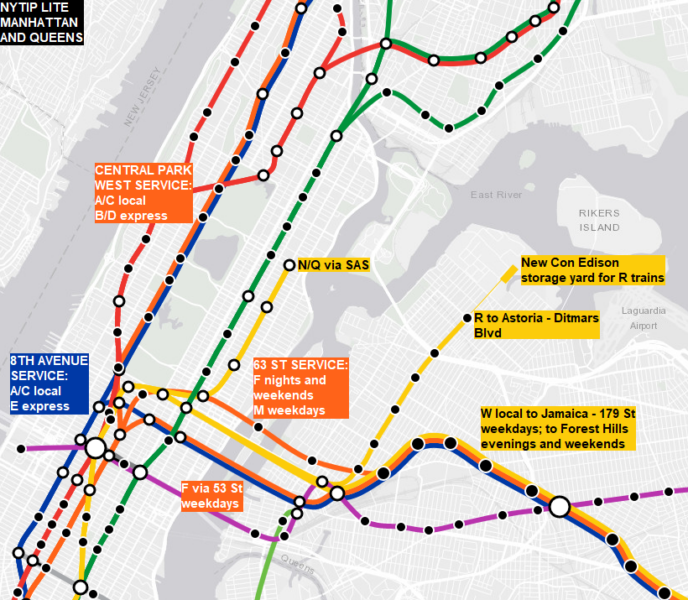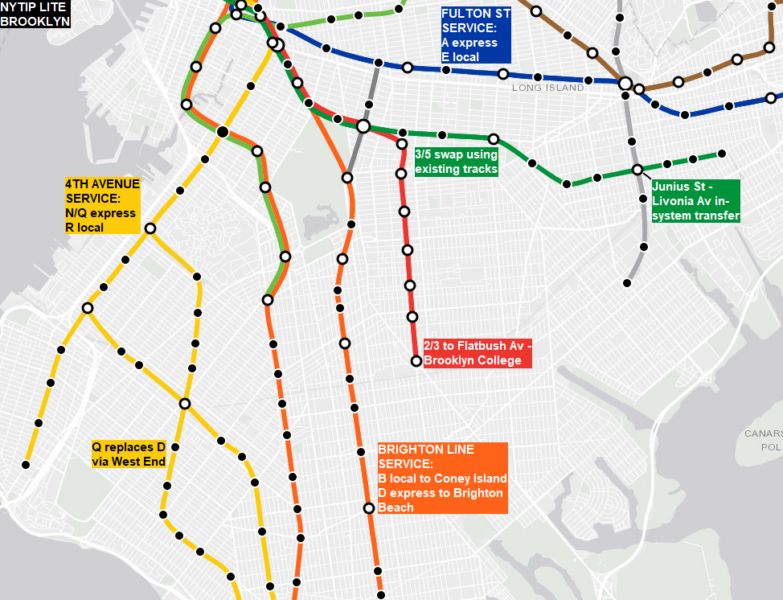UPDATE (12.13.2021): Post revised to reflect updates to the enhanced NYC subway.
The novel coronavirus, a.k.a. COVID-19, wreaked havoc on mass transit systems nationwide. In NYC, lockdowns, telework, changes in commuting behavior, and increased wariness about transit use led to massive ridership drops on subways, buses, and commuter rail. Worse, vehicular traffic has already returned to pre-pandemic levels – and it’ll likely worsen.
With no sign of relief in sight, the MTA warned of doomsday cuts at a level not seen in decades. Given these dire circumstances, where does that leave NYTIP?
Find out on this edition of the NYTIP INSIDER.
Note: Click any image to enlarge.
Over the last few years, I’ve worked on NYTIP – a series of ideas for improving New York’s transport infrastructure. The work-in-progress consists of both short-term and long-term strategies. With the fiscal crisis brought on by COVID-19 – along federal and state inaction – some say now isn’t the time to talk about subway expansion.
Yet things like pandemics and budget shortfalls don’t seem to affect highway projects like this one. Or this one. Or this one. Or this one.
Among others.
Which is why I’m not convinced by arguments stating we shouldn’t discuss subway improvements and expansions. As with all things transport in NY, the question of dollars and cents ultimately comes down to politics and priorities.
And on transport, it’s clear NY does not have its priorities in order! However, there is light at the end of this dark tunnel.
Recall my three-point plan to fix the NYC Subway – enhance, extend, and expand. The centerpiece of point one – enhance – is de-interlining, or reducing merging conflicts. This theoretically allows every line to run every 4 minutes or better during peak hours and every 8 minutes or better during off-peak hours. However, the Rona-induced ridership shock led to service cuts on several lines, with service every 12 minutes on weekends instead of every 10 minutes.
With the MTA in dire straits (though less so now with over 55% subway ridership recovery), let us consider a less-ambitious initial goal – service every 5 minutes or better during peak hours, and every 10 minutes or better off-peak. Then ramp up to 4/8 when ridership and funding recover, and then push for 3/6. With this in mind, let us also limit initial proposals to those possible with little to no capital investment. Given these constraints, how can we jump-start NYC subway service to encourage ridership?
Allow me to introduce NYTIP Lite.
[Figs. 1, 2, 3] Overview of NYTIP Lite. Created using Brand New Subway.
The Bronx and Upper Manhattan
NYTIP Lite prescribes the following service changes in The Bronx and Upper Manhattan:
- Concourse line: The C replaces the B to Bedford Park Boulevard; however, the C only runs on weekdays. Peak-directional D express service expands to weekdays until 8:00 PM.
- White Plains Road and Dyre Avenue lines: Split 5 service ends; all 2 trains run to Wakefield – 241st Street and all 5 trains run to Eastchester – Dyre Avenue. Peak-directional 5 express service expands to weekdays until 8:00 PM.
- Inwood line: The B replaces the A and runs express, while the A replaces the C and runs local.
Manhattan
NYTIP Lite prescribes the following service changes in Manhattan:
- Central Park West line: A/C local, B/D express.
- 8th Avenue line: A/C local, E express.
- Broadway line:
- N trains skip 49th Street and run via 63rd Street and the Second Avenue Subway.
- N and Q trains run express via the Manhattan Bridge, while R and W trains run local via Lower Manhattan.
- F trains run via 53rd Street on weekdays and via 63rd Street on nights and weekends.
- M trains run via 63rd Street on weekdays.
Queens
NYTIP Lite prescribes the following service changes in Queens:
- Astoria line: The R replaces the N and W to Ditmars Boulevard with increased service.
- Optional capital investment: Construct new storage yard within Con Edison property in Astoria.
- Queens Boulevard line:
- E and F trains run express, while M and W trains run local (W replaces R on Queens Boulevard).
- W trains run to Jamaica – 179th Street on weekdays and to Forest Hills – 71st Avenue on weekends.
Brooklyn
NYTIP Lite prescribes the following service changes in Brooklyn:
- Eastern Parkway line:
- 3 and 5 trains swap terminals using existing tracks; some conflicts still exist, but this change simplifies train movements through Nostrand Junction.
- Required capital investment: Convert the out-of-system transfer between the Junius Street (5) and Livonia Avenue (L) stations into an in-system transfer.
- 4th Avenue line:
- N and Q trains run express, while the R train runs local.
- Q replaces D via West End.
- Brighton line: The B runs local to Coney Island, while the D runs express to Brighton Beach.
- Fulton Street line: The E replaces the C via Fulton local, while A express service is unchanged.
Summary
NYTIP Lite is essentially a “welcome back” package for NYC Subway riders. Almost all of the proposed changes under NYTIP Lite are operational changes, which would allow a quick rollout. These changes reduce merging conflicts and allow service increases on several lines. Let’s not let the Rona dictate our transport priorities – for New York’s long-term well-being, #SaveTransit!
Here is the NYTIP Lite service guide. It is a Microsoft Excel file (16 kB).




I like this plan. It’s definitely doable…assuming the will is there at the MTA (“will” doesn’t seem to work at the MTA very much). But I would like to suggest switching your B and D in Brooklyn, so the B goes to Stillwell and the D to Bay Ridge. I think it would be easier to have a B shuttle based out of Coney Island as opposed to Concourse (which would likely have to happen if the B is rerouted to Bay Ridge). Running the D 24/7 between 205th St and 95th St-Bay Ridge should be a pretty simple operation. Over in Queens, I like having the W as the main QB local, because its shorter two-borough route would be more reliable than the current R service is.
Hi Mike, thanks for your comment!
I agree about “will” when it comes to MTA, which is sad. NY has the capability to realize a much better transit system, but that capability often gets drowned by politics.
I will consider your suggestion regarding the B and D in Brooklyn. My thought with sending the B to Bay Ridge was to retain D service to Coney Island, but swapping them can work too.